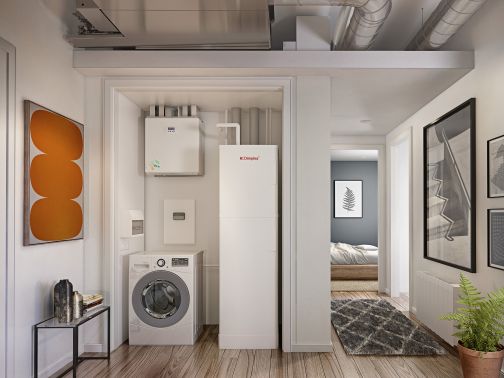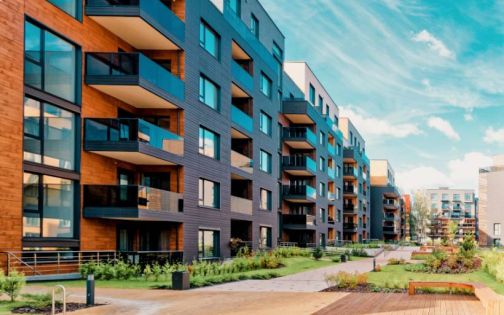Only installed ambient network HVAC solution

The Zeroth Energy System is currently the first modern ambient loop to be installed in multiple projects across the UK, offering a range of benefits that were designed to answer the challenges of HVAC system integration in large residential developments. The communal network uses an ambient central energy loop and in-apartment water-to-water heat pumps to efficiently deliver low carbon heating, cooling, and domestic hot water. The three main challenges the innovative solution addresses are:
- Compliance and energy efficiency
- Spatial limitations and ease of installation
- Occupant comfort, cost and control
Ambient loops, also called ambient networks, are fast becoming a technology that promises to help deliver healthy, more sustainable and compliant residential buildings with a reduced carbon footprint that can get us closer to the net zero 2050 target. You can find out how in-apartment heat pumps on ambient loops work here. The Zeroth Energy System is the only solution of its kind designed and manufactured in the UK in collaboration with leading developers to address specific challenges of the UK residential property market.
The Zeroth Energy System is currently the only ambient network solution of its kind implemented in residential and mixed-use developments. The completed projects give a valuable insight into the benefits ambient loop can offer for modern construction and provide us with measurable results on not just the design but the working application of these new systems.
How does the Zeroth Energy System help improve the energy efficiency of a building and overcome compliance challenges?
As Building Regulations are set to increase the efficiency of our buildings and tighten carbon reduction targets, the recent installation of the Zeroth Energy System at Harbour Lofts in Poole illustrates how the technology can help. The regeneration project by Acorn Property Group was an example of local planning restrictions, carbon performance targets and design restrictions posing a challenge to the specification of a compliant HVAC solution. The design of the Zeroth Energy System proposed by GDHV features internal air source heat pumps (ASHP), a buffer tank in the plant room and underfloor heating in the apartments. To read more on how the solution helped achieve compliance and deliver the design objectives for this project, read our Harbour Lofts case study.
The Zeroth Energy System addresses the inefficiencies of traditional high temperature communal systems. GDHV testing shows that the Zeroth Energy System can reduce distribution losses by up to 90% when compared to these systems. As a result, the system helps design out overheating in modern, well insulated buildings. You can find out more on how this can be achieved here. Simultaneously, the energy efficiency of the system increases. To illustrate the efficiencies of the Zeroth Energy System further and show the benefits of having working installations to monitor, consider the example that the domestic hot water (DHW) heat loss, as measured by EN15332 in kWh/24h, is 1.63. When measured in a real installation of the Zeroth Energy System, the figure is in fact significantly lower at 1.1.
The coefficient of performance (COP) for in-apartment heat pumps available on the market currently varies. In the context of overall ambient network efficiency, the seasonal coefficient of performance (SCOP) should also be considered. Combining ambient loop with a renewable energy source, for example an air source heat pump as the central plant, can offer excellent SCOP. You can find out more on this, and how the Zeroth Energy System can help reduce HVAC system CO2 emissions here and also how it can help achieve compliance in large residential developments here.

How does the Zeroth Energy System help with spatial limitations and installation speed?
Plant room, infrastructure and apartment living space requirements of HVAC systems can be a decisive specification factor, especially where valuable usable footprint of the building can be freed up. The completed development by Galliard Homes in London Leyton’s Church Road is an example of how the Zeroth Energy System can help maximise the building footprint. A limited electrical supply coupled with significant plant room space restrictions made integration of traditional central plant heating technology within the development difficult. This could not be overcome by rearranging the design of the original system.
The design temperature of the central loop of the Zeroth Energy System at 25 °C reduced the required output in comparison with a high temperature system, so reducing the central plant size. Air source heat pumps (ASHP) were installed on the roof of the building, addressing the plant location and size issue. The Zeroth Heat Pump, which contains an integrated water cylinder, installed in each apartment are sized to fit a standard utility cupboard. Again, this meant even more valuable space was made available in the building.
The weight of the in-apartment unit at 178kg (empty) is around 40kg less than market competitors, allowing for easier handling. Unlike similar products on the market, the majority of the Zeroth Energy System components are housed within the unit. This means the system can be delivered pre-wired and pre-plumbed, significantly reducing onsite installation time and cost. The use of non-flammable refrigerant also contributes to lower ongoing costs of maintenance. The Church Road installation demonstrates the benefits of industry-driven innovation. For more information, read the full case study here.
How can the Zeroth Energy System improve occupant thermal and acoustic comfort?
Increasing outdoor temperatures mean there is a growing need for HVAC solutions that can improve occupant thermal comfort all year round. Whilst the heating load of compliant buildings is reduced with the improved thermal performance of the building envelope, a new challenge arises to keep occupants cool during summers. The internal heat gains generated by occupants combined with the external heat penetrating modern lightweight building materials limit the impact of passive cooling measures. However, if cooling and mechanical ventilation are specified, the energy efficiency of these systems is pivotal. Here, ambient loop can offer a feasible alternative to traditional cooling systems.
The Zeroth Energy System can deliver low carbon cooling to large residential developments and can also work alongside mechanical ventilation systems. To deliver comfort cooling efficiently, the system utilises the waste energy from the space and hot water heating process. Conversely, the waste energy from the cooling process can be transferred to the water cylinder to provide thermal energy for hot water delivery. This feature sets the Zeroth Energy System apart from other ambient loops available on the market. Lendlease trialled the Zeroth Energy System in the Elephant Park regeneration project with the aim to create a long-term strategy for delivery of sustainable new communal developments. The trial ambient network installation was specified with underfloor heating and fan coils for comfort cooling. The Zeroth Energy System has also been specified to deliver heating and comfort cooling with the same emitters for a major development in East London.
The Zeroth Energy System with Natural Air 180 mechanical ventilation with heat recovery units (MVHR) were recently installed at The Factory (Dundonald Church), a development in south London. The spatial constraints and the requirement of a minimum of 35% on-site carbon improvement against Part L as required by the Greater London Authority (GLA) proved a considerable challenge. The Zeroth Energy System was the only technology capable of overcoming the challenges of this project. Mark Bryan, MEP Director of Meinhardt who consulted on the project, adds: “The Zeroth technology offers a route for dwellings to provide low carbon heat based on a product of the future. We are very much looking forward to seeing how this system operates as a critical step of reducing our carbon dioxide emissions”.
Noise reduction and effective end user controls were pivotal to the mixed-use project. The Zeroth Energy Systems noise levels for the 6kW are slightly higher than the 4kW model, with a sound pressure of 25dBA and sound power at 36dBA. This is around 5dBA less than comparable systems. The occupant comfort was significantly improved and although the services were supplied through the centralised Zeroth Energy System, easy to use in-apartment controls were installed to give occupiers the freedom to set their own comfort limits. The Zeroth Energy System is not limited to manufacturer controls and allows for complete flexibility of controls specification. Find out more about The Factory project here.
To find out more about the Zeroth Energy System or to discuss your project in detail, contact our HVAC specialists.








